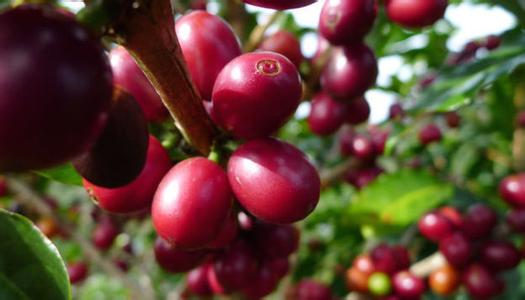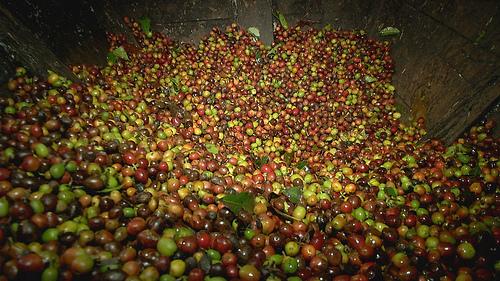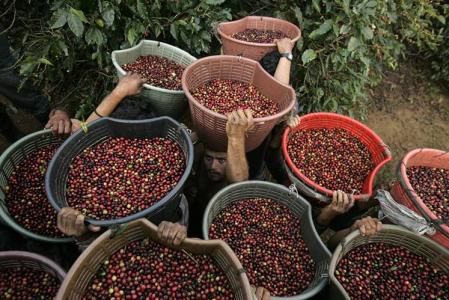What kind of fruit decomposition diagram is the fruit of coffee?
What kind of fruit decomposition diagram is the fruit of coffee?
Robasta coffee trees are native to Madagascar in central and western Africa and Indonesia in Asia, and account for about 20% to 30% of the world's output. Robasta coffee tree is suitable for planting in the lowlands below 500 meters above sea level, has strong adaptability to the environment, can resist bad climate, resist diseases and insect pests, and does not need much artificial care during soil preparation, weeding and pruning. It can be allowed to grow in the wild, and it is a kind of coffee tree that is easy to cultivate. But its finished product tastes more bitter than Arabica, its caffeine content is higher, and its quality is much lower, so it is mostly used to make instant (instant) coffee. Since it is mainly produced in Africa, most Africans drink robastian coffee.
With the different regions, climates and even elevations of coffee producing areas, each factor has a key influence on the choice of treatment methods. Therefore, no matter which method of treatment, the structure of each layer of fruit has its different intention. The following are the more common treatments:
The inner pericarp is also covered with a layer of sticky material called pectin. If you want to take out the coffee beans, you have to remove the pulp, pectin and endocarp. Coffee beans basically grow opposite to each other. So one side of the coffee bean will be flat. This kind of coffee bean has a flat side, we call it "flat bean". Some coffee fruits grow only one seed (5%-20% of the total), which is due to pollination or environmental factors, resulting in a serious deterioration of the seed growth on one side, which looks round (in this case, the seeds on the other side will not be produced), this round coffee bean, we call it "round bean". In the coffee bean sorting process (distinguishing the size and picking out the coffee beans of poor quality), the "round beans" should be selected from the "flat beans". As the number of coffee beans is rare, they should be sold differently from the coffee beans that they are used to. Coffee beans in Brazil, Blue Mountain and other places are very famous, and the price is higher than that of coffee beans. But for farmers, there should be two coffee beans in one fruit.
The height of the coffee garden is controlled at about 2 meters, and most of the planting requirements for Arabica tree species are in high altitude areas, most of which are not conducive to mechanical fruit harvesting, and most of them are picked manually. At present, the main picking methods in the world are mechanical harvesting and manual picking.

Important Notice :
前街咖啡 FrontStreet Coffee has moved to new addredd:
FrontStreet Coffee Address: 315,Donghua East Road,GuangZhou
Tel:020 38364473
- Prev

Flavor description of washed bourbon coffee beans in Honduras taste grinding scale
Description of the flavor of Honduran washed bourbon coffee beans the grinding scale is from Pacamara in the Santa Barbara region. Pacamara is a hybrid of Maragogype (Ironka variety, Malaggippe, also known as elephant bean) and Pacas (bourbon variety, Pacas). It inherits the large-grain bean shape of Maragogype and is recognized in the world.
- Next

What is the type of fruit flavor of coffee? describe the taste treatment method of producing area.
What is the type of coffee fruit flavor description the height of the coffee garden in the law-producing area is controlled at about 2 meters, and most of the Arabica tree species are planted at high altitude. most of the fruits in high altitude areas are not conducive to mechanical harvesting, and most of them are picked manually. At present, the main picking methods in the world are mechanical harvesting and manual picking of coffee beans.
Related
- What brand of black coffee is the most authentic and delicious? what are the characteristics of the flavor of the authentic Rose Summer Black Coffee?
- Introduction to the principle and characteristics of the correct use of mocha pot A detailed course of mocha pot brewing coffee is described in five steps.
- Which is better, decaf or regular coffee? how is decaf made?
- How much is a bag of four cat coffee?
- How about four Cat Coffee or Nestle Coffee? why is it a cheap scam?
- Which is better, Yunnan four Cats Coffee or Nestle Coffee? How about cat coffee? is it a fake scam? why is it so cheap?
- How about Cat Coffee? what grade is a hoax? which instant coffee tastes better, four Cat Coffee, Nestle Coffee or G7 coffee?
- Process flow chart of coffee making-Starbucks coffee making process what coffee tastes good at Starbucks
- The top ten best coffee beans in the world Rose summer coffee or Tanzanian coffee tastes good
- Yunnan four cat coffee is good to drink?_four cat coffee is a big brand? four cat blue mountain coffee is fake?

